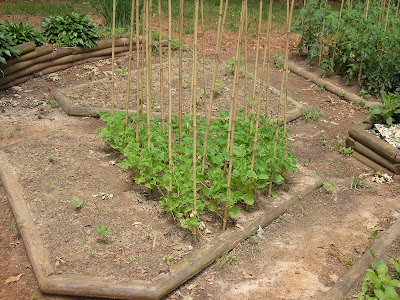
Notice Tomato and Pepper Stakes: May 13, 2010

Green Bean Stake & Trellis: May 13, 2010

Tomato Stakes: May 13, 2010
Therefore, proper structures set up around the plants not only improve stability, but they also keep the fruit well off the ground. There are several ways to do this. A popular way is to use stakes, whether wood or bamboo. Trellises are also used, but they can be expensive if made from metal.
I use some kind of stake and trellis combo, and this year I decided to buy a large number of bamboo stakes. They are much less expensive if bought in bulk, but they need to be dried out before use to reduce rotting at the base. Here are some tips on structuring:
1. It is important to structure the plants when they are young so that plant survivability is increased from the beginning. This can be done when the plants are older, but you do run the risk of damaging the root system at this point.
2. With regard to the rope used for the stakes/trellis, I use a strong twine that is not expensive and does not cut into the stem of the plant. Aesthetically, brown twine tends to blend in against the bamboo.
3. When tying the plants to the stake/trellis, be careful not to 'cut' into the stem. The plant should be firmly bound, but the stem should not be severed. This could kill the plant immediately or open it up to infection and disease. This is why I do not reccomend fishing line. Furthermore, as the plants grows taller, continue to tie the main stem to the stake/trellis every 6-12 inches.
4. Stakes should be pounded into the ground at least a foot if at all possible to help stablize the plants when wind and hail approach. If the the stake is driven too shallow, it could fall over and do more harm than good by breaking the plant it is attached to or even other surrounding plants.
5. Tall stakes are preferable because this allows for plenty of height should the plant increase in height substantially. For example, right now, my tomato plants are about six weeks old and at or almost 2 1/2 feet tall. If I had short stakes, they would have already almost out-grown them very early in the growing season. My stakes are 7 feet long, and one foot of that is in the ground, so the plants have plenty of growing height left.
6. Three common garden varieties that I reccommend staking/trellising are tomatoes, peppers, and beans/peas. I even encourage giving the peppers plenty of potential growing height, for last year my pepper plants were tall, and the jalapeno plant was about 6 feet or more!
Staking/trellissing does take time and effort, but the rewards are well worth the work. The structures don't have to cost a lot, but they do require some effort, and the long term benefits will put a smile on your face and the face of those who enjoy the fruit of your labor!
Happy Gardening! To Him be glory! Amen!
4. Stakes should be pounded into the ground at least a foot if at all possible to help stablize the plants when wind and hail approach. If the the stake is driven too shallow, it could fall over and do more harm than good by breaking the plant it is attached to or even other surrounding plants.
5. Tall stakes are preferable because this allows for plenty of height should the plant increase in height substantially. For example, right now, my tomato plants are about six weeks old and at or almost 2 1/2 feet tall. If I had short stakes, they would have already almost out-grown them very early in the growing season. My stakes are 7 feet long, and one foot of that is in the ground, so the plants have plenty of growing height left.
6. Three common garden varieties that I reccommend staking/trellising are tomatoes, peppers, and beans/peas. I even encourage giving the peppers plenty of potential growing height, for last year my pepper plants were tall, and the jalapeno plant was about 6 feet or more!
Staking/trellissing does take time and effort, but the rewards are well worth the work. The structures don't have to cost a lot, but they do require some effort, and the long term benefits will put a smile on your face and the face of those who enjoy the fruit of your labor!
Happy Gardening! To Him be glory! Amen!

2 comments:
The garden looks great! Your plants are much larger than mine are.
The plants look very close together, are you worried about crowding them?
Also, I see you are using bamboo supports. Have you seen The Tomato Stake. In my opinion, its the best, easiest, and strongest tomato support I've ever seen and used.
Thanks for the encouragement. I am not too concerned about crowding. The plants still have breathing room, and the soil they are in is quite fertile. Because we tend to receive quite a bit of rain here, the large plants tend to soak the water up quickly and therefore reduces potential drowning problems.
Post a Comment